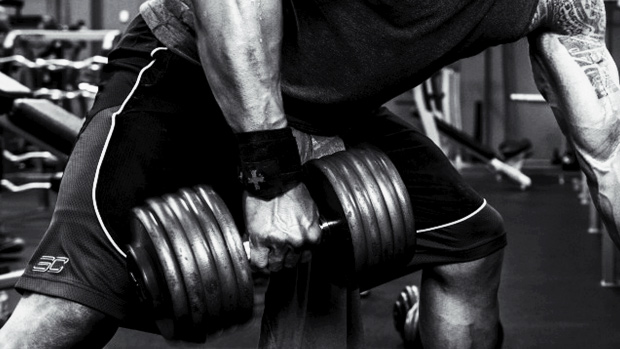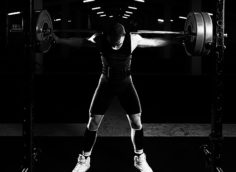Dumbbell rows are a proven staple for back training. They're great for the lats, posterior delts, teres major, trapezius, and rhomboids. But there are also a lot of misconceptions about them. Here's what you need to know.
If you saw a normal-sized person doing Kroc rows, you'd think they're using too heavy of a weight and using poor form to cheat the heck out of the lift. Would you think the same thing if it was some monster strongman doing them? No, probably not. You'd just say he was doing Kroc rows.
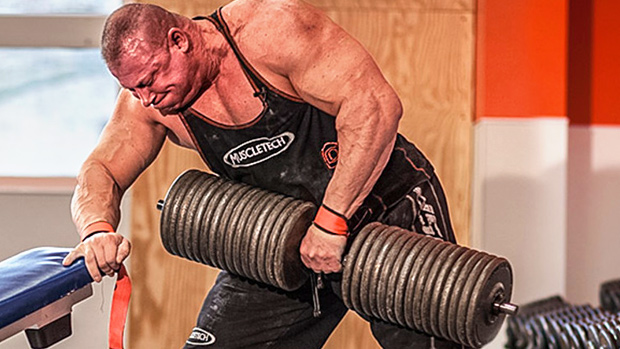
Look, we need to remain logically consistent on training principles. We need to understand the context of what we're doing because training principles aren't determined by how big one's back is or what his lifting totals are.
I've read that Kroc used them for heavy, high reps (sets of 20) specifically because he felt it helped improve his deadlift performance. So using Kroc rows for that purpose makes good sense, just like using kipping pull-ups makes sense for some (CrossFit competitors).
However, most people aren't powerlifters and they need to think about the context of exercises such as Kroc rows. If you're someone who's trying to do one-arm rows to develop strength in the involved muscles, then using your legs and hips to launch (instead of lift) that weight up isn't the way to do it.
If you're looking for a form-focused, high-volume alternative to Kroc rows, look no further than the 747 hybrid row.
Do these row variations back-to-back without rest until you've completed all three exercises with both arms:
- A1. One-Arm Free Standing Dumbbell Row, 7 reps each arm
- A2. One-Arm Supported Dumbbell Row, 4 reps each arm using a heavier load that A1
- A3. One-Arm Dumbbell Off-Bench Row, 7 reps using a slightly lighter load than used on A1
- Perform 2-3 sets with 4-6 minutes between sets.
Coaching Tips
- One-Arm Free Standing Dumbbell Row: Use a weight you can do for 8-9 reps with good form. Keeping your shoulders parallel to the ground, rotate it slightly toward the same side you're holding the dumbbell on. This forces you to use of your mid-back through the full range of motion involved at the top of the exercise.
- One-Arm Dumbbell Row: The additional base of support allows you to pull heavier loads. Push your support arm into the bench as you row the dumbbell with your other arm. Explode into the weight on each rep. The weight won't go up fast (despite your intent to lift it fast) because you'll be using the heaviest weight you can manage for four reps.
- One-Arm Dumbbell Off-Bench Row: Perform with your torso parallel to the floor using a weight you can do for more than 8 reps with good form. This move offers more base of support than free-standing rows, but less than the traditional dumbbell rows with your knee on the bench. That makes it a nice middle ground between the first two exercises.
Additional Notes
- The less base of support you have when doing a dumbbell row, the more you've got to use your hips and torso to stay in place. So mixing up the row variations slightly changes the muscular demand and also keeps this protocol more interesting than a traditional high-rep set.
- You can do this same rep scheme using the same dumbbell row variation if you'd like.
- The 747 rep scheme isn't some magic rep number, so you can tweak it a bit. In fact, sometimes you may only get 6 reps on the final exercise due to fatigue. Or maybe you get 9 reps on the final exercise because you're feeling like an animal.
It's common for coaches to recommend that you should be able to pull double what you can push as a general strength standard. First off, there are two different contexts in which this recommendation can be used. The first context makes some sense... and the other not so much.
In one context, it can be used as a general programming recommendation to dedicate double the amount of training volume to pulling exercises than you do to pushing exercises. There can certainly be merit to this recommendation if you're interested in emphasizing the backside of your body. In that, research shows that there seems to be a dose-response to gains in muscle size and strength (1,2).
In the other context, "pull double what you push" means you should be able to do double the amount of reps in horizontal pulling exercises with the same weight you used for a similar horizontal pushing exercise. Or that you're 1RM horizontal pulling strength should be double that of your 1RM horizontal pushing strength.
But this goes against the relevant scientific evidence and doesn't make sense from a biomechanics perspective.
When performing horizontal rows, the lever-arm (moment arm) is at its longest when your humerus (your "biceps bone") is perpendicular to the force vector. So, if you're doing barbell bent-over rows or one-arm dumbbell rows with your torso roughly parallel to the floor, the lever-arm is at its longest when your humerus is parallel with the floor.
This means that as you get closer to the concentric end of the range of motion involved in rowing (horizontal pulling) exercises, you're not only losing a mechanical advantage over the load (because the lever-arm is getting longer), you're also getting weaker because muscles have the lowest potential to generate force when they're fully shortened (contracted).
Now, if you look at anatomy alone, you might conclude that you should be able to pull much more than you can push because the pulling musculature is much larger than the pushing musculature. But this paints an incomplete and therefore inaccurate picture. It fails to consider the biomechanical realities involved in pushing and pulling, which offset the differences in anatomical structure.
As you perform a horizontal pushing exercise, you're gaining a mechanical advantage on the load, whereas when you're performing a horizontal pulling exercise, you get weaker as the weight is getting heavier (because the lever-arm is getting longer).
In short, doubling your pulling volume has some merit as a programming recommendation... in certain instances. For example, the stereotypical gym bro who mainly does chest and arms could benefit from such advice. But I wouldn't use it as a blanket programming recommendation or as a principle for everyone else to follow.
When doing rows (using a barbell, dumbbell, cable, etc.), the weight gets heavier as you row the weight towards you because you're losing a mechanical advantage over the weight. Well, resistance bands get "heavier" as you stretch them. This is why I don't recommend attaching bands to barbells, dumbbells, or to plate-loaded machines when doing rows.
Many trainers falsely believe that adding resistance bands to free weight and plate-loaded exercises creates "accommodating resistance." The resistance is only accommodating when the band getting heavier corresponds with you gaining a mechanical advantage over the load as you do the lift, such as what occurs when doing a free weight or machine chest press, deadlift, Romanian deadlift, squat, leg press, etc.
However, the opposite occurs when adding bands to rows, which creates UN-accommodating resistance. And, when the resistance curve is increasing as your strength curve is decreasing, it forces you to cheat. This is why we see lifters pull the weight halfway with good form and then jolt it the rest of the way when doing bent-over rows and one-arm dumbbell rows.
It's also why you see so many people turning their torso towards their rowing arm as they pull the dumbbell in on dumbbell rows, along with seeing people staying too upright on bent-over barbell rows and one-arm rows, or leaning back too far when doing seated rows or machine rows. The addition of bands simply magnifies these cheats.
That said, there are two instances where I might recommend using bands on rows:
- Attached to free weights or a plate-loaded machine using a light load for dynamic effort (fast) reps. Bands allow you to move fast, which is why they're great for dynamic effort type work, but the weight needs to be light in order to maximize speed.
- When you're traveling or working out at home or outdoors and all you've got is a set of bands with handles.
There's at least one great way to use a resistance band with one-arm dumbbell rows, but it's not quite the same way that I often see people performing them. Usually, I see them doing banded dumbbell rows with the band around their wrist or the band around the dumbbell handle, with the dumbbell anchored low.
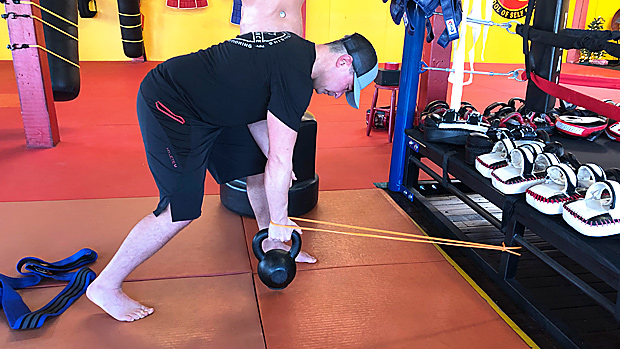
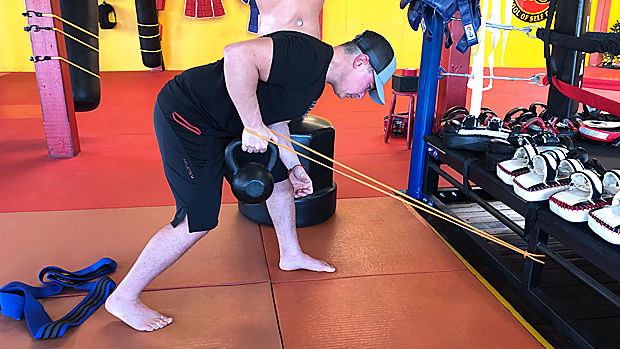
This is done to create more mechanical tension at the bottom of the dumbbell row where you'd normally allow your arms to just hang. The idea is to make you work through a greater range of motion. It's a great concept, but anchoring the band low and placing it around your wrist or the dumbbell creates two issues at the top of the row that are probably not what most lifters are after.
First, the top position of doing banded rows in this manner mimics that of the starting position of a low-cable triceps kickback, and all the band is going to do is either pull your elbow farther into flexion or increase the triceps demand to keep your elbow at 90-degrees.
The second issue is that the low anchor point of the band creates UN-accommodating resistance (as described above) to an exercise that already involves you losing a mechanical advantage as you pull the weight into you.
So I recommend performing banded dumbbell rows with 1) the band anchored directly above the shoulder of your rowing arm when you're in the bent-over position to begin the row, and 2) around the top of your forearm, just below your elbow.
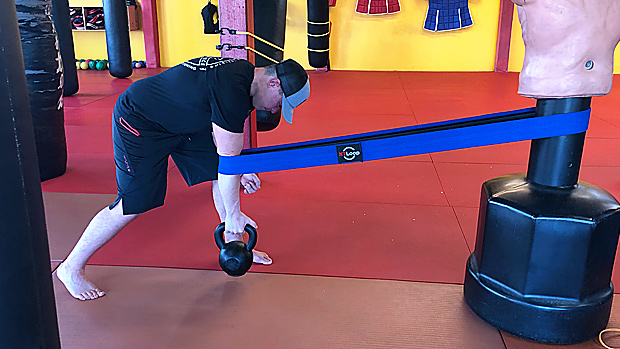
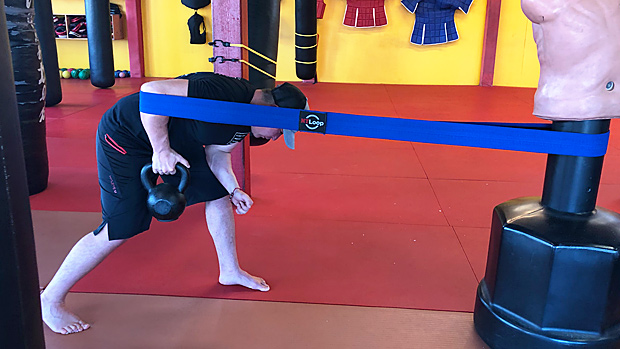
This setup still makes you do the extra work at the bottom position when your arm is hanging below your shoulders, but it doesn't create the two issues I mentioned because this setup gives you a mechanical advantage on the band as you get closer to the top position.
Note that I'm using an NT Loop instead of a traditional latex band because I designed them to be a far more comfortable and stable band to place around your limbs, waist, or hips.
(This last one's more of a public service announcement.) Most lifters know not to curl in the squat rack, but they'll certainly do one-arm rows while bracing their other arm on the dumbbell rack.
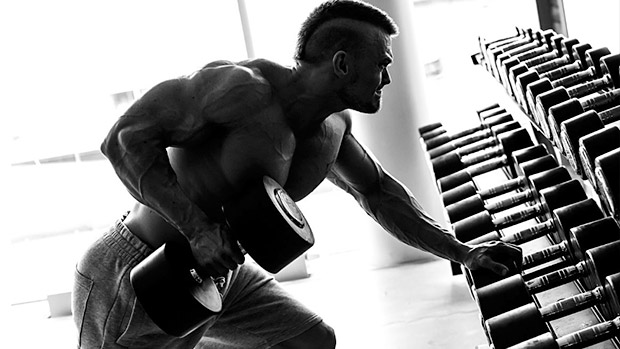
Not only are they blocking that whole section of the dumbbells from everyone else, they've also got their whole body sticking out so far there's no room to walk behind them between their ass and the benches. You've got to weave around the benches like you're going through security at the airport.
This is way worse than curling in the squat rack because you're not just consuming one piece of equipment for an exercise that you could do elsewhere, you're also consuming an entire section of the dumbbell rack and getting in everyone else's way. Yeah, don't do that.
- Schoenfeld BJ et al. Effects of Resistance Training Frequency on Measures of Muscle Hypertrophy: A Systematic Review and Meta-Analysis. Sports Med. 2016 Nov;46(11):1689-1697. PubMed.
- Schoenfeld BJ et al. Dose-response relationship between weekly resistance training volume and increases in muscle mass: A systematic review and meta-analysis. J Sports Sci. 2017 Jun;35(11):1073-1082. PubMed.
- Negrete RJ et al. Upper Body Push And Pull Strength Ratio In Recreationally Active Adults. Int J Sports Phys Ther
. 2013 Apr;8(2):138-44. PubMed. - Pearson SN et al. Kinematics and kinetics of the bench-press and bench-pull exercises in a strength-trained sporting population. Sports Biomech. 2009 Sep;8(3):245-54. PubMed.
T Nation earns from qualifying purchases as an Amazon Associate. Read more about our policy.

